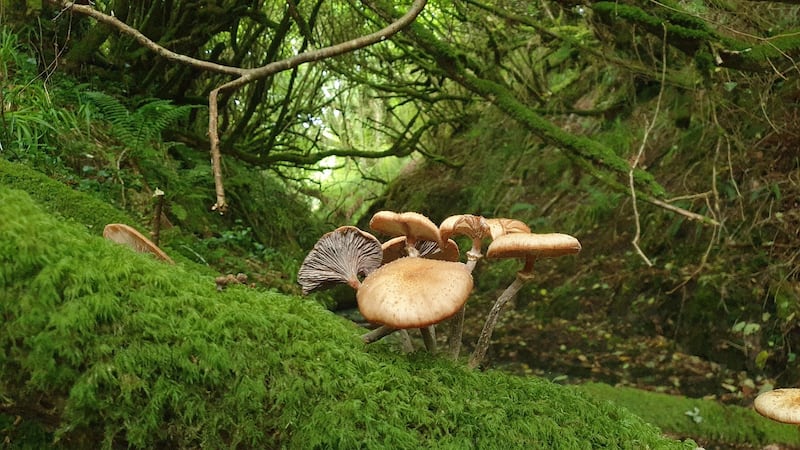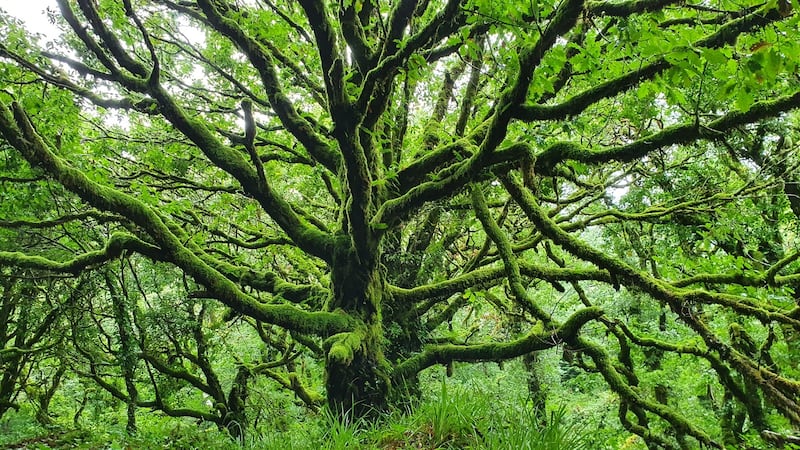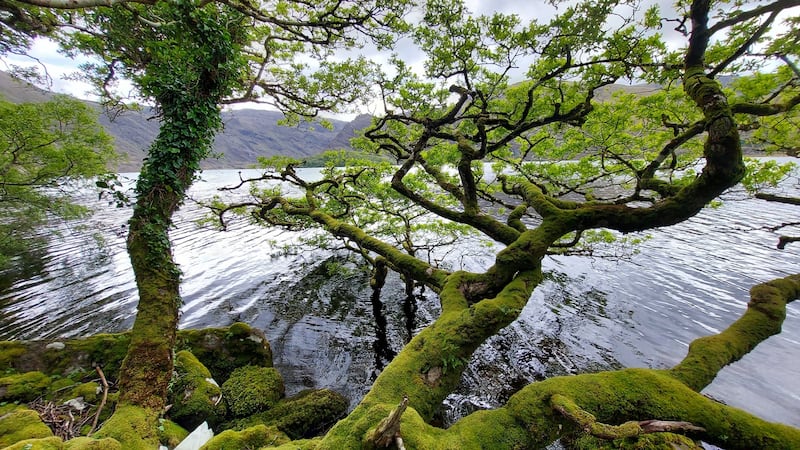Imagine if Ireland suddenly discovered an entirely new, and very rare, ecosystem right beneath our noses.
It sounds impossible. And yet it is precisely what has been happening over recent years as more and more people have come to realise that this island has managed to cling on to a unique and endangered natural habitat called the oceanic temperate rainforest.
This moss-clad, tangled thicket of stunted, gnarled woodland is often rich in birch and willow and can have ash, hazel, oak and alder also growing through it. Many of us have likely seen such places, at the base of a valley, or on a sloping Atlantic-facing hill. They are part of our natural landscape, but we’ve just never given them much thought before. They’ve been hiding in plain sight.
Most often you catch sight of them in illustrated fairy books or described in mythical tales, like those of JRR Tolkien. A character will be trekking through the coiling, wet branches of a temperate rainforest with moist-leaved epiphytic plants dropping down on top of them. They represent the archetype of magical woodland.
The fact that they still exist in the Irish landscape has become obscured by their isolation and fragmentation. Nowadays, you are likely to only find small patches of them scattered in overlooked corners, yet they were once widespread. It’s definitely about time we paused to take a moment to truly appreciate these wet, spongy clusters of woodland that are so often covered with mosses, liverworts, lichens and ferns.

A key identifying feature of a temperate rainforest is its sheer wetness, with some branches so sodden and rotten that they crumble to the touch and there’s a squelch to the rock-strewn, bramble-tangled, fern-rich ground that is far removed from a typical, dry, rustling, forest floor. So, whether you’ve seen them and ignored them, or have never had the good fortunate of encountering one, this is an exciting moment, as we are getting to learn more about, and beginning to explore, a form of rainforest that is every bit as unique, biodiverse and endangered as tropical rainforests.
Beyond their ecological importance, which is almost unquantifiable in its breadth and extent, there is also a sociological and psychological importance to them for us as a society. The key is in our name, Gael. The term “Irish” is modern and English. It doesn’t really represent who we were. We were Gaels. We still are. At one time we all spoke Gaeilge, language of the Gaels. And Gael means “forest people” or “wild men”. We come from the bush, from these wet, dank thickets of woodlands that once covered three-quarters of the island.

It was wrong to ever label us as bog men. We are, in fact, much closer to bushmen. It was in wet, mulchy woodlands such as these temperate rainforests that our ancestors first settled. They are our natural habitat and over millennia we gradually developed our lives, minds, culture and society in them, around them and through them. They are the environment that shaped and honed us as people, moulded our psyche and imaginations.
When we think of our forebears, Fionn Mac Cumhail and his hunter-gatherer band of Fianna, patrolling the wood it is through these dense, damp, contorted thickets of decomposing woodland that we picture them tramping, rather than some stark grove of oak trees or the gaunt, drabness of a spruce plantation. Perhaps our past determination to cut down every last tree and drain every damp bit of land was to hide this facet of our past – the dark secret that we evolved out of woodland, like our ape ancestors before us. The truth is that we were once as reliant on and enmeshed in the woodlands as any other species of forest fauna.
Yet, no matter what the reason for our complex relationship to woodland in the past, it's vital that we reassess it now and begin as a matter of urgency to rejuvenate the remaining wet woodlands that still cling on in forgotten pockets across the island. To help us get a better sense of them hometree.ie, a native woodland charity based in west Clare, has published a sumptuously illustrated book called Under Summer Pastures: explorations and essays from Ireland temperate rainforests, with contributions from the likes of Pádraic Fogerty, Paul Kingsnorth and Mark Boyle.

There is also an alluring Twitter feed, @IrishRainforest, run by Eoghan Daltun, who for more than 12 years has been caring for 70 acres of species-rich Atlantic rainforest on the Beara Peninsula.
Restoring and extending these vital habitats will not only help the diverse range of flora and fauna that rely upon them, but also help alleviate flood damage, cleanse our drinking water, sequester carbon, purify our air and assist us all in reconnecting to the native landscape that our culture evolved in.
We know that trees played a central role in our psychological make-up, our ceremonial rituals and native cures. We are fortunate to still have tracts of the indigenous rainforest that these trees developed in clinging on throughout the island. All of us should now be doing whatever we possibly can to safeguard them for the future, not only for ourselves, but for our ancestors, and the animals, insects and future of life on this planet.
Under Summer Pastures: explorations and essays from Ireland temperate rainforests can be purchased from hometree.ie









